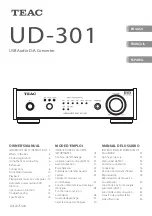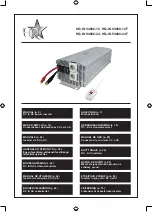
3.5 CLEANING THE GENERATOR
Keep the generator as clean and as dry as possible. Dirt and mois-
ture that accumulate on internal generator windings have adversely
affect insulation resistance.
Periodically, clean the generator’s exterior surfaces. A soft brush
may be used to loosen caked-on dirt. Use a vacuum system or
dry, low-pressure air to remove any accumulations of dirt. The
generator is housed inside an all-weather enclosure; clean the
enclosure with a soft, damp cloth or with sponge and water.
Once each year, have the generator cleaned and inspected by an
Authorized Service Dealer. Service technicians will use dry, low-
pressure air to clean internal windings. Parts inside the control
console should be cleaned and inspected at this time, as well.
Finally, have the insulation resistance of stator and rotor windings
checked. If insulation resistances are excessively low, the genera-
tor may require drying.
DO NOT use a forceful spray of water to
clean the generator. Water will enter the gen-
erator interior and cause problems, and may
also contaminate the generator fuel system.
3.6 BATTERY MAINTENANCE
All lead-acid batteries will discharge when not in use. The genera-
tor battery should be inspected per the “Service Schedule”. The
following procedure should be used for inspection:
• Inspect the battery posts and cables for tightness and corro-
sion. Tighten and clean as necessary.
• Check the battery fluid level of unsealed batteries and, if nec-
essary, fill with Distilled Water Only. Do not use tap water in
batteries.
• Have the state of charge and condition checked by an
Authorized Service Dealer.
NOTE:
Servicing of the battery is to be performed or supervised by
knowledgeable personnel, according to the required precau-
tions. Keep unauthorized personnel away from batteries.
Damage will result if the battery connections are made in
reverse.
DO NOT dispose of the battery in a fire. The
battery is capable of exploding. Storage bat-
teries release explosive hydrogen gas. This
gas can form an explosive mixture around
the battery for several hours after charging.
The slightest spark can ignite the gas and
cause an explosion. Such an explosion can
shatter the battery and cause blindness or
other injury. Any area that houses a storage
battery must be properly ventilated. Do not
allow smoking, open flame, sparks, or any
spark-producing tool or equipment near the
battery. Discharge static electricity from body
before touching the battery by first touching
a grounded metal surface.
A battery presents a risk of electrical shock
and high short-circuit current. The following
precautions are to be observed when work-
ing on batteries:
• Remove watches, rings, and other metal
objects;
• Use tools with insulated handles;
• Wear rubber gloves and boots;
• Do not lay tools or metal parts on top of the
battery;
• Disconnect any charging source prior to con-
necting, or disconnecting, battery terminals;
and
• Do not use any jumper cables or booster bat-
tery to crank and start the generator engine.
If any battery has discharged, remove it for
recharging.
DO NOT open or mutilate the battery.
Released electrolyte has been known to be
harmful to the skin and eyes, and to be toxic.
The electrolyte is a dilute sulfuric acid that is
harmful to the skin and eyes. It is electrically
conductive and corrosive. The following
procedures are to be observed:
• Wear full eye protection and protective clothing;
• Immediately wash with water all skin areas that
come into contact with the electrolyte.
• If the electrolyte contacts the eyes, immediately
flush eyes thoroughly with water, and seek
medical attention.
13
Maintenance
Summary of Contents for quietpact 85d
Page 23: ...21 Figure 1 2 Major Features and Dimensions Drawing 0G6806 A General Information ...
Page 40: ...38 Electrical Data Schematic 120 240 VAC Output Drawing No 0G7332 C ...
Page 41: ...39 Schematic 120 240 VAC Output Drawing No 0G7332 C Electrical Data ...
Page 42: ...40 Electrical Data Schematic 120 240 Dual Voltage Drawing No 0G7333 D ...
Page 43: ...41 Schematic 120 240 Dual Voltage Drawing No 0G7333 D Electrical Data ...
Page 44: ...42 Electrical Data Schematic 120 240 Dual Voltage Drawing No 0G7333 D ...
Page 45: ...43 Schematic 120 240 Dual Voltage Drawing No 0G7333 D Electrical Data ...
Page 46: ...44 Exploded Views Parts Lists Engine Alternator Starter Assy Drawing No 0G7350 B ...
Page 48: ...46 Exploded Views Parts Lists Enclosure Drawing No 0G7351 B ...
Page 50: ...48 Exploded Views Parts Lists Cooling System Drawing No 0G7352 B ...
Page 52: ...50 Exploded Views Parts Lists Fuel Electrical Systems Drawing No 0G7355 A ...
Page 54: ...52 Exploded Views Parts Lists Customer Controls Assy Drawing No 0G7356 B ...
Page 73: ......
Page 75: ......
Page 77: ......
Page 79: ......
Page 81: ......
Page 83: ......
Page 85: ......
Page 87: ......
Page 89: ......
Page 91: ......
Page 93: ......
Page 95: ......
Page 97: ......
Page 99: ......
Page 101: ......
Page 103: ......
Page 105: ......
Page 107: ......
Page 108: ......
Page 109: ......
Page 110: ......
Page 111: ......
Page 112: ......















































